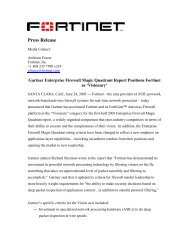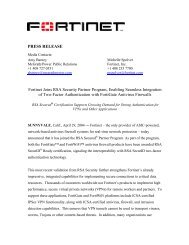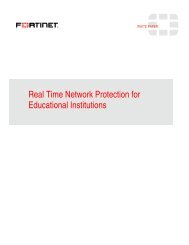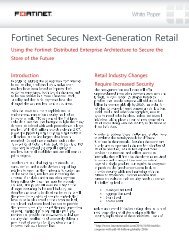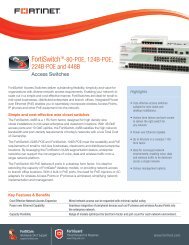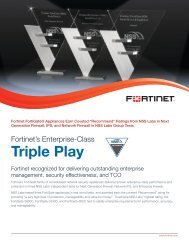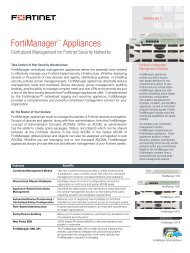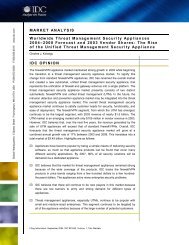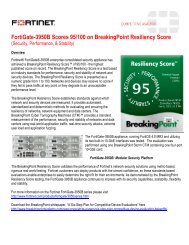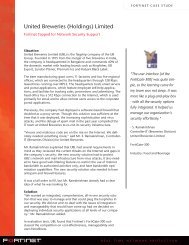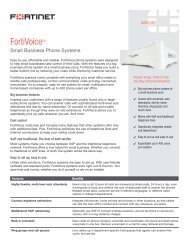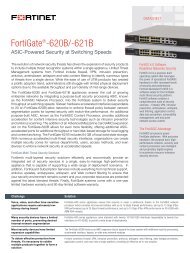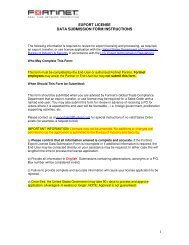FortiMail Identity Based Encryption - A Business Enabler - Fortinet
FortiMail Identity Based Encryption - A Business Enabler - Fortinet
FortiMail Identity Based Encryption - A Business Enabler - Fortinet
Create successful ePaper yourself
Turn your PDF publications into a flip-book with our unique Google optimized e-Paper software.
<strong>FortiMail</strong> <strong>Identity</strong> <strong>Based</strong> <strong>Encryption</strong><br />
A <strong>Business</strong> <strong>Enabler</strong><br />
WHITE PAPER
FORTINET – <strong>FortiMail</strong> <strong>Identity</strong> <strong>Based</strong> <strong>Encryption</strong> - A <strong>Business</strong> <strong>Enabler</strong> PAGE 2<br />
Contents<br />
<strong>Business</strong> Need Secure Mail Delivery ............................................................................................................................. 3<br />
Challenges with Available Technologies ........................................................................................................................ 3<br />
S/MIME ...................................................................................................................................................................... 3<br />
PGP ........................................................................................................................................................................... 3<br />
<strong>FortiMail</strong> Solutions.......................................................................................................................................................... 4<br />
<strong>FortiMail</strong> Overview ..................................................................................................................................................... 4<br />
<strong>FortiMail</strong> <strong>Identity</strong>-<strong>Based</strong> <strong>Encryption</strong> ........................................................................................................................... 4<br />
<strong>Identity</strong>-<strong>Based</strong> <strong>Encryption</strong> .............................................................................................................................................. 5<br />
How IBE Works .......................................................................................................................................................... 5<br />
Push and Pull for Secure Delivery ............................................................................................................................. 5<br />
Customized Notification ............................................................................................................................................. 6<br />
IBE <strong>Encryption</strong> Options .............................................................................................................................................. 7<br />
User Enrollment and Secure Mail Access .................................................................................................................. 7<br />
Deployment Options ................................................................................................................................................... 8<br />
Case Studies .................................................................................................................................................................. 9<br />
Case One: Financial Services Industry ...................................................................................................................... 9<br />
Case Two: Healthcare Clinic/Hospital ...................................................................................................................... 10<br />
Summary ...................................................................................................................................................................... 11
FORTINET – <strong>FortiMail</strong> <strong>Identity</strong> <strong>Based</strong> <strong>Encryption</strong> - A <strong>Business</strong> <strong>Enabler</strong> PAGE 3<br />
<strong>Business</strong> Need Secure Mail Delivery<br />
Email has evolved into one of the most important methods of communication for any organization. However, its lack<br />
of security creates abundant opportunities for misuse and fraud -- every non-encrypted email sent over a network<br />
can be read, copied or altered during transmission.<br />
There is a strong business need for secure mail delivery:<br />
Industries such as healthcare, finance and government must comply with regulations to protect sensitive data in<br />
electronic communication<br />
Secure mail delivery significantly reduces the costs associated with printing, faxing and overnight delivery of<br />
paper-based communication<br />
Secure mail delivery enables online business channels as it facilitates sharing confidential, regulated, or<br />
proprietary information with customers, employees, clients and partners in safe, secure manner<br />
Challenges with Available Technologies<br />
The two most popular tools available today for secure messaging are Secure/Multipurpose Internet Mail Extensions<br />
(S/MIME) and Pretty Good Privacy (PGP) encrypted communication, and Transport Layer Security (TLS) secure<br />
connections. In spite of their popularity, these technologies each present significant operational challenges to<br />
organizations wishing to deploy encrypted messaging.<br />
S/MIME<br />
S/MIME is a standard for public key encryption and signing of MIME data. It was originally developed by RSA Data<br />
Security, Inc. to provide cryptographic security services for electronic messaging applications including<br />
authentication, message integrity and non-repudiation of origin (using digital signatures), and privacy and data<br />
security (using encryption). Before S/MIME can be used in any of the above applications, one must obtain and install<br />
an individual key/certificate either from one's in-house certificate authority (CA) or from a public CA.<br />
However, there are many obstacles to deploying S/MIME in practice. First, not all e-mail software supports S/MIME<br />
signatures, resulting in an attachment called smime.p7s that may confuse recipients. Second, S/MIME is not<br />
supported for most web-based email clients, such as Gmail, Hotmail. Third, S/MIME is tailored for end-to-end<br />
security which introduces the drawback of encrypting not only the message, but also any malware, defeating the<br />
purpose of Firewall which normally sits at the company gateway and won’t be able to identify the encrypted malware.<br />
Last but not least, some users don’t take advantages of S/MIME because of the administrative overhead of issuing,<br />
maintaining, and revoking certificates.<br />
PGP<br />
Pretty Good Privacy (PGP) is a data encryption and decryption computer program and is often used for signing,<br />
encrypting, and decrypting emails to increase the security of email communications. PGP is a hybrid solution; it ties<br />
together the advantages of public key and symmetric cryptography by combining the convenience of public-key<br />
encryption with the fast speed of symmetric encryption.<br />
While PGP is considered a better practice than S/MIME among security professionals, it does have its<br />
disadvantages:<br />
Complexity – using PGP can be a complex process and its implementation is often difficult.<br />
Compatibility – it is impossible to use PGP unless people at both ends of the connection are using the same<br />
version of PGP<br />
Key management – managing keys can be challenging for users who are new to PGP. Keys that are lost or<br />
corrupted can be a security risk to users in a highly secure environment
FORTINET – <strong>FortiMail</strong> <strong>Identity</strong> <strong>Based</strong> <strong>Encryption</strong> - A <strong>Business</strong> <strong>Enabler</strong> PAGE 4<br />
In summary, overall usability is as important a consideration as security. The certificate and key management<br />
challenges described above prevent organizations from deploying PGP and S/MIME to all users. Any encryption<br />
solution that is difficult to deploy and use will result in limited deployments and end-users avoiding the tools’ usage,<br />
which results in poor practices and potential exposure for the organization. Organizations are looking for a secure<br />
mail encryption solution they can easily deploy and their users can readily adopt.<br />
<strong>FortiMail</strong> Solutions<br />
<strong>FortiMail</strong> Overview<br />
<strong>Fortinet</strong>’s <strong>FortiMail</strong> secure messaging systems are purpose-built antispam/antivirus systems that protect<br />
organizations of all sizes against message-borne threats. Its flexibility and versatility provide a turnkey approach to<br />
secure and clean corporate communication.<br />
You can prevent your messaging systems from becoming threat delivery systems with <strong>FortiMail</strong>. Its inbound filtering<br />
engine blocks spam and malware before it can clog your network and affect users. Its outbound inspection<br />
technology prevents outbound spam or malware from causing other antispam gateways to blacklist your users<br />
(including mobile traffic). The <strong>FortiMail</strong> platform’s dynamic and static user blocking gives you granular control over all<br />
of your policies and users.<br />
Three deployment modes offer maximum versatility while minimizing infrastructure changes or service disruptions:<br />
transparent mode for seamless integration into existing networks with no changes to your existing mail server,<br />
gateway mode as a proxy MTA for existing messaging gateways, or full messaging server functionality for remote<br />
locations.<br />
<strong>FortiMail</strong> <strong>Identity</strong>-<strong>Based</strong> <strong>Encryption</strong><br />
<strong>FortiMail</strong> provides <strong>Identity</strong>-<strong>Based</strong> <strong>Encryption</strong> (IBE), in addition to S/MIME and TLS/SSL, as email encryption options<br />
to enforce policy-based encryption for secure content delivery. There are many benefits of using <strong>FortiMail</strong> IBE:<br />
Security – <strong>FortiMail</strong> IBE can be used in conjunction with any other services provided by <strong>FortiMail</strong>, such as<br />
antispam, antivirus and content filtering, to provide an extra layer of email protection.<br />
Easy to use – <strong>FortiMail</strong> IBE is as easy to use as a standard email. There is no need of certificate and key<br />
management for end-users and no need to install additional hardware or software. The recipient does not<br />
have to generate key pairs in order to read the encrypted document. No end-user provisioning and preenrollment<br />
requirements eliminate the need for end-user training and maintenance costs. <strong>FortiMail</strong> IBE<br />
enhances data security without impacting your productivity.<br />
Flexibility – <strong>FortiMail</strong> is one of the very few products on the market that offer IBE in both Push and Pull<br />
delivery options, delivering encrypted emails directly to your users, or storing them on the <strong>FortiMail</strong> platform<br />
for retrieval, or a combination of the two options.<br />
Reduces Cost – Eliminates the per-letter cost and environmental impact of paper-based communications.<br />
According to the Direct Marketing Association1 , the approximate cost for 100,000 pieces of direct mail is<br />
$1.00 per letter. Replacing 100,000 letters to its customers a year with <strong>FortiMail</strong> secure mail delivery will<br />
save approximately $100,000 yearly, and flow directly to the bottom line.<br />
Lowers Total Cost of Ownership – <strong>FortiMail</strong> IBE is available on all <strong>FortiMail</strong> appliances and in any mode of<br />
operation (Transparent, Gateway, and Server), without additional charges.<br />
1 www.the-dma-org.org
FORTINET – <strong>FortiMail</strong> <strong>Identity</strong> <strong>Based</strong> <strong>Encryption</strong> - A <strong>Business</strong> <strong>Enabler</strong> PAGE 5<br />
<strong>Identity</strong>-<strong>Based</strong> <strong>Encryption</strong><br />
How IBE Works<br />
IBE is a type of public-key cryptography that uses unique information about the identity of the user to generate the<br />
public key. <strong>FortiMail</strong> uses a recipient’s email address as well as other unique parameters (such as time stamp) to<br />
create the public key. You can enable automatic encryption of messages based on the attributes you choose, such<br />
as subject content, message body, or recipient domain. When an outbound email arrives at the <strong>FortiMail</strong> unit, it<br />
applies predefined policies to determine if the message requires encryption. If there is a policy match, the <strong>FortiMail</strong><br />
unit automatically encrypts the message using the public key.<br />
The recipient of the message can decrypt it regardless of his operating system, mail client or user privilege. A<br />
browser-based method allows the recipient to decrypt and read the secure message. There is no need for additional<br />
software or the installation of any plug-in before <strong>FortiMail</strong> can send an encrypted message. <strong>FortiMail</strong> secure mail<br />
delivery can interoperate with any email client, including Lotus Notes, Thunderbird and Webmail such as Gmail,<br />
Yahoo, Hotmail, and so forth.<br />
Push and Pull for Secure Delivery<br />
<strong>FortiMail</strong> offers two options to deliver encrypted messages – the Pull method and the Push method. The<br />
administrator has the flexibility to configure it to use either the push or the pull approach based on the message size.<br />
For instance, he can configure to use the Push approach for emails less than 1MB and use the Pull approach for<br />
emails greater than 1MB.<br />
Pull Method (the encrypted email is stored on the <strong>FortiMail</strong> device)<br />
1. The <strong>FortiMail</strong> device sends the recipient an email to notify that a new encrypted message is available.<br />
2. Recipient clicks on the HTTPS link in the notification, which creates a web browser-based SSL connection<br />
with the originating <strong>FortiMail</strong> device.<br />
3. The recipient authenticates with <strong>FortiMail</strong> (typically the recipient will authenticate via LDAP). The first-time<br />
user will have to register to create an account on the <strong>FortiMail</strong> local database.<br />
4. The <strong>FortiMail</strong> issues the private key to decrypt the email and the user opens the encrypted email.<br />
Please see Figure 1 for the detailed procedures of the Pull Method and Figure 3 for an example of the<br />
notification.<br />
1. Mail is sent by<br />
email client<br />
2. Mail matches an<br />
encryption policy<br />
1<br />
3. Encrypted mail is<br />
stored on <strong>FortiMail</strong> in a<br />
secure mailbox<br />
3<br />
6<br />
6. Recipient is<br />
registered &<br />
authenticated<br />
4<br />
7<br />
4. A notification email is sent to<br />
the recipient which includes a<br />
web link<br />
7. Message is displayed<br />
through a webmail<br />
interface<br />
Figure 1: <strong>FortiMail</strong> IBE Pull Method<br />
MTA<br />
5. Recipient accesses<br />
the embedded URL<br />
5
FORTINET – <strong>FortiMail</strong> <strong>Identity</strong> <strong>Based</strong> <strong>Encryption</strong> - A <strong>Business</strong> <strong>Enabler</strong> PAGE 6<br />
Push Method (the encrypted email is sent to the user)<br />
1. The <strong>FortiMail</strong> sends the recipient a notification message with an encrypted HTML attachment.<br />
2. The recipient clicks on the attachment (the encrypted message), which creates a web browser-based<br />
SSL connection with the originating <strong>FortiMail</strong> device.<br />
3. The recipient’s web browser “POSTs” the encrypted data in the attachment to the <strong>FortiMail</strong> for decryption.<br />
4. The recipient authenticates with the <strong>FortiMail</strong> device (a first-time user will have to register to create<br />
an account).<br />
5. The <strong>FortiMail</strong> decrypts the email, and the recipient reads and replies to the email.<br />
Please see Figure 2 for the detailed procedures of the Push Method and Figure 3 for an example of the<br />
notification. The differences between the Push and Pull Methods are highlighted in yellow.<br />
1. Mail is sent by<br />
email client<br />
2. Mail matches an<br />
encryption policy<br />
1<br />
3. Message is<br />
encrypted in<br />
HTML format<br />
3<br />
6<br />
6. Recipient is<br />
registered &<br />
authenticated<br />
7<br />
4<br />
4. A notification is sent to the<br />
recipient with the HTML<br />
payload as attachment<br />
7. Message is displayed<br />
through a secure<br />
webmail interface<br />
Figure 2: <strong>FortiMail</strong> IBE Push Method<br />
MTA<br />
5. Recipient opens the<br />
attachment<br />
Customized Notification<br />
<strong>FortiMail</strong> IBE offers you the flexibility to customize the notification message in either HTML or plain text format.<br />
Please see Figure 3 for an example of the notification email for the Pull method, posting the encrypted payload as an<br />
HTTPS link to the <strong>FortiMail</strong> device, and an example for the Push method in HTML format, the encrypted payload is<br />
delivered as an attachment.<br />
5
FORTINET – <strong>FortiMail</strong> <strong>Identity</strong> <strong>Based</strong> <strong>Encryption</strong> - A <strong>Business</strong> <strong>Enabler</strong> PAGE 7<br />
With Push Method<br />
encrypted payload is<br />
delivered as an<br />
attachment<br />
With Pull Method<br />
encrypted payload is<br />
posted as a link<br />
Figure 3: Notification Messages<br />
IBE <strong>Encryption</strong> Options<br />
<strong>FortiMail</strong> IBE supports encryption algorithms including 3DES, AES128, AES192, AES256 and CAST5 128. When the<br />
IBE server itself is unavailable, <strong>FortiMail</strong> provides alternative options to enforce TLS, drop and send DSN or send<br />
plain message. Please see Figure 4 for a screen shot on <strong>FortiMail</strong> management interface.<br />
Figure 4: <strong>FortiMail</strong> <strong>Encryption</strong> Profile<br />
User Enrollment and Secure Mail Access<br />
IBE enrollment process doesn’t require any administrative effort or maintenance. It uses the email address as the<br />
user’s identity. User accounts can be stored on local <strong>FortiMail</strong> storage or an external NFS or iSCSI storage server.<br />
New users will have to complete a short online form for registration (Figure 5).
FORTINET – <strong>FortiMail</strong> <strong>Identity</strong> <strong>Based</strong> <strong>Encryption</strong> - A <strong>Business</strong> <strong>Enabler</strong> PAGE 8<br />
Figure 5: New User Registration Form<br />
After successful enrollment, the recipient can manage secured emails on the <strong>FortiMail</strong> system. The administrator can<br />
customize the legal disclaimer and company logos. The interface is identical to the webmail interface in server mode.<br />
Please see Figure 6 for the screen shot.<br />
The confidential email is<br />
displayed to the user through<br />
a webmail interface<br />
Figure 6 <strong>FortiMail</strong> Secure Mail Access<br />
Deployment Options<br />
You can assign mail storage, encryption, decryption and webmail access functions to a specific <strong>FortiMail</strong> unit. An<br />
optional deployment scenario is to configure a dedicated <strong>FortiMail</strong> unit as the centralized encryption and decryption<br />
unit. This dedicated secure device would help to shift the extra load of encryption and decryption from the other<br />
<strong>FortiMail</strong> gateways. Emails are transferred to the dedicated device the same way quarantined emails are transferred.
FORTINET – <strong>FortiMail</strong> <strong>Identity</strong> <strong>Based</strong> <strong>Encryption</strong> - A <strong>Business</strong> <strong>Enabler</strong> PAGE 9<br />
Case Studies<br />
Case One: Financial Services Industry<br />
Common requirements:<br />
Confidentiality: Financial services companies are required to protect<br />
any electronic communication that includes sensitive data, such as<br />
account numbers, location of account, social security numbers,<br />
customer names and/or addresses, etc.<br />
Preventing phishing threats: Users continue to face a barrage of<br />
fraudulent emails, looking to fool users into divulging account details<br />
and other personal information.<br />
Regulation: Many organizations are facing internal, as well as industry and government regulations for<br />
secure communication. For example, SOX section 404 compliance requires secure and authenticated<br />
delivery of email messages to ensure privacy and confidentiality.<br />
<strong>FortiMail</strong> Benefits:<br />
Ease of use: <strong>Identity</strong> <strong>Based</strong> <strong>Encryption</strong> (IBE) ensures privacy by using the recipient and other<br />
random factors to create unique user-based keys. There is no need of certification and key<br />
management. No additional hardware or software to install. No user provisioning and preenrollment<br />
requirements.<br />
Multi-layered protection: Coupled with FortiGuard Labs’ industry leading real-time security<br />
services, <strong>FortiMail</strong> provides complete multi-layered antivirus, antispam, antispyware, and<br />
antiphishing security protection with a performance that will not affect your users or delay<br />
their communications.<br />
Compliance: Pre-defined HIPAA, SOX, and GLB lexical dictionaries are customizable and are<br />
included on every <strong>FortiMail</strong> appliance.<br />
Data Leak Protection: Pre-defined "Smart Identifiers" intelligently detect the accidental or<br />
intentional loss of confidential or regulated data. You can choose to block messages<br />
containing data matching a range of patterns or create policies to enforce the encryption of<br />
messages carrying this data, such as Credit Card or Social Security Numbers. DLP aids in<br />
PCI/DSS and HIPAA compliance.<br />
Compatibility: Support for non TLS/SSL capable SMTP domains by utilizing TLS/SSL over<br />
HTTP (HTTPS). Sensitive messages sent to domains that do not support SMTP encryption<br />
will use HTTP encryption.<br />
Flexibility: Provide both Push and Pull secure mail delivery capabilities. Pull messages reside<br />
on the appliance, while Push messages reside in the recipient inbox.<br />
Cost effective: IBE is available on all <strong>FortiMail</strong> appliances and in any mode of operation<br />
without an extra license or fees. Integrated security with no per-user or per-mailbox pricing.<br />
Deployment Example: A Medium-sized Financial Services Company in New England USA<br />
This company was looking for secure email solutions to prevent its sensitive insurance policy and personal<br />
information from being exposed to unauthorized users, while maintaining usability. It also needed to prevent Data<br />
Leakage, such as Social Security Number, Credit Card strings, and Canadian SIN. Once detected, it wanted to<br />
encrypt this email before sending to large customers and partners. The customer didn’t want to manage desktop<br />
email encryption solutions like PGP Desktop. It was also facing a budget constraint and didn’t want to pay costly perseat<br />
licensing.
FORTINET – <strong>FortiMail</strong> <strong>Identity</strong> <strong>Based</strong> <strong>Encryption</strong> - A <strong>Business</strong> <strong>Enabler</strong> PAGE 10<br />
Although the client had many questions about usability of <strong>Fortinet</strong>’s IBE solution, the sales team was able to<br />
demonstrate exactly why IBE is so powerful and easy for the customer to use on a daily basis. This customer bought<br />
<strong>FortiMail</strong> because of the centralized administration, ease of use for the external encryption recipients, and SOX<br />
compliance. A single <strong>FortiMail</strong> 100C platform was deployed, and it processed approximately 20,000 messages per<br />
day. The project was so successful the customer decided to add another device to ensure High Availability.<br />
Case Two: Healthcare Clinic/Hospital<br />
Common requirements:<br />
Confidentiality: Patient information and medical data sent by<br />
emails, such as lab reports sent to a physician, emails from a<br />
doctor to another practitioner consulting for a second opinion,<br />
are private and highly sensitive.<br />
Regulation: HIPAA and similar regulations around the world<br />
require that healthcare providers ensure the confidentiality of<br />
patient information and medical record. Unauthorized<br />
disclosure of protected health information (PHI) is punishable<br />
by fines<br />
Extended use of IT: To mitigate financial risks many health care providers have resorted to faxing or post<br />
mails to deliver sensitive information which significantly increase operational costs.<br />
<strong>FortiMail</strong> Benefits:<br />
DLP and Compliance: Pre-defined HIPAA, SOX, and GLB lexical dictionaries are customizable and on every<br />
<strong>FortiMail</strong> appliance. Automatically enforce privacy policies with PHI content scanning. Thanks to dictionaries<br />
or lexicon search that identifies PHI elements, <strong>FortiMail</strong> is able to detect and protect confidential information.<br />
Ease of use: <strong>FortiMail</strong> IBE is as easy to use as regular mail system. There is no need of certification and key<br />
management. No additional hardware or software to install. No user provisioning and pre-enrollment<br />
requirements. <strong>FortiMail</strong> allow leveraging mail as a means of health record communication.<br />
Automatically and manually triggered encryption: IBE can be triggered automatically when there is a policy<br />
match. Or the user can manually trigger IBE by specifying certain keywords in the message Subject or Body.<br />
Flexibility: Provide both Push and Pull secure mail delivery capabilities. Pull messages reside on the<br />
appliance, while Push messages reside in the recipient inbox.<br />
Cost effective: IBE is available on all <strong>FortiMail</strong> appliances and in any mode of operation without an extra<br />
license or fees. Integrated security with no per-user or per-mailbox pricing.<br />
Deployment Example: A Medium-sized Health Insurance Company in US<br />
This customer has a requirement to become HIPAA compliant, and secure all potentially sensitive information<br />
contained in outbound email messages, without the intervention of the senders. The customer also wishes to enable<br />
the internal users to manually trigger IBE.<br />
A <strong>FortiMail</strong>-1000B is deployed as the last internal hop outbound and is configured to scan all outgoing messages for<br />
sensitive content or keywords specified by the company management. The customer takes advantage of the predefined<br />
HIPAA dictionary to enable its content monitoring policy. All potentially sensitive information is detected and<br />
secured. The automatic message encryption also occurs when a sender specifies certain keywords in the <strong>FortiMail</strong><br />
system, such as “[secure]” or “[confidential]”. For example, when a user puts [secure] in the message Subject or<br />
Body, the <strong>FortiMail</strong> will trigger IBE to encrypt the message automatically.
FORTINET – <strong>FortiMail</strong> <strong>Identity</strong> <strong>Based</strong> <strong>Encryption</strong> - A <strong>Business</strong> <strong>Enabler</strong> PAGE 11<br />
Summary<br />
<strong>Business</strong>es require secure mail delivery to meet policy requirements and provide a competitive advantage.<br />
Organizations are looking for alternatives to the certificate and key management challenges posed by existing<br />
solutions. They want an encryption solution that is easy to deploy and use and meets policy requirements for secure<br />
communicaitons.<br />
<strong>FortiMail</strong> IBE is as easy to use as standard email system--there is no need for certificate or key management for endusers,<br />
and no need to install additional hardware or software. A browser-based method allows the recipient to<br />
decrypt and read the secure message regardless of his operating system, mail client or user privilege. <strong>FortiMail</strong><br />
enables organizations to eliminate the per-letter cost and environmental impact of paper-based communications,<br />
resulting in measurable cost savings. <strong>FortiMail</strong> IBE is an ideal secure mail solution for healthcare, financial services,<br />
government and legal organizations.<br />
FML-WP-IBE-R1-201101



